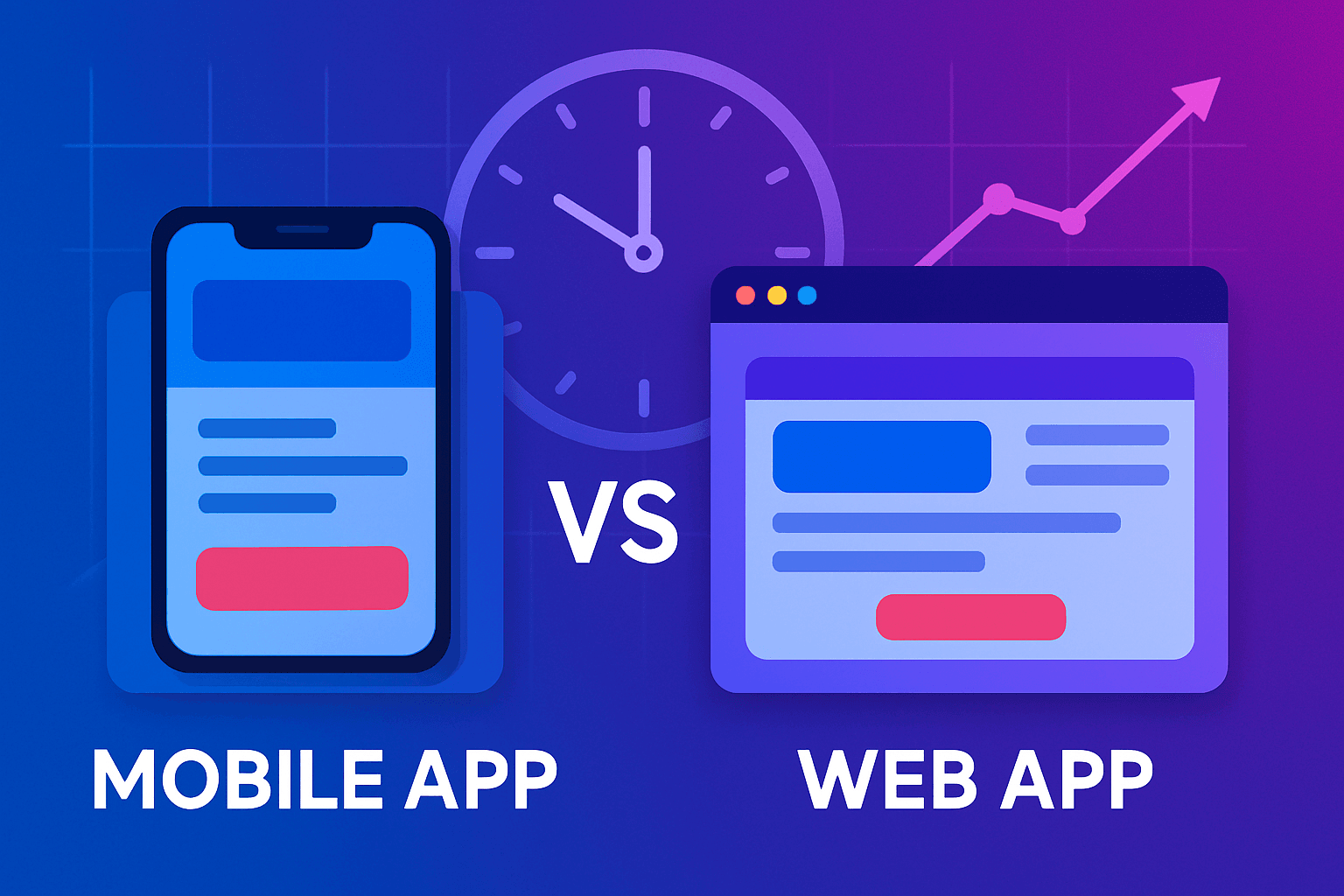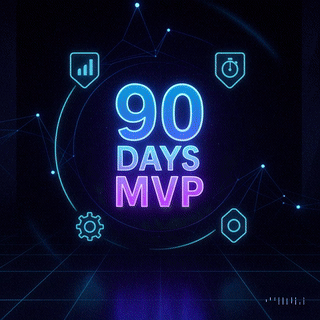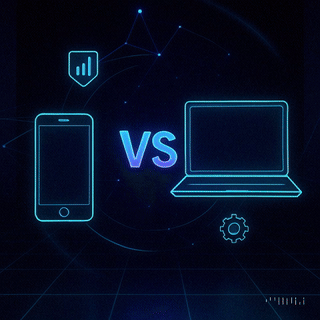Let's Make It Happen
Propelius Technologies
Based in India working worldwide
Mobile App vs Web App: Which to Build First for Your SaaS
May 21, 2025
14 min read

Mobile App vs Web App: Which to Build First for Your SaaS
Deciding between a mobile app or web app for your SaaS product? Here’s the short answer:
- If your users need on-the-go access, push notifications, or device-specific features like GPS or camera, start with a mobile app.
- If you’re prioritizing quick development, lower costs, or broad accessibility across devices, go for a web app.
Key Factors to Consider:
- Development Speed & Cost: Web apps are faster and cheaper to build. Mobile apps cost more but offer better performance.
- User Experience: Mobile apps integrate with device features and work offline. Web apps are easier to access and update.
- User Habits: Build a mobile app if your audience spends more time on phones. Choose a web app for desktop-focused tasks.
Quick Comparison Table:
| Factor | Web App | Mobile App |
|---|---|---|
| Development Cost | $5,000–$15,000 (basic MVP) | $15,000–$40,000 (basic MVP) |
| Time to Market | 3–6 weeks | 4–8 weeks (store approval) |
| Offline Access | Limited | Often available |
| Device Features | Limited to browser capabilities | Full integration (GPS, camera) |
| User Engagement | Lower | Higher |
| Ease of Updates | Instant server-side updates | Requires user action |
Bottom Line:
Start with a web app for faster validation and lower costs. Choose a mobile app if your product relies on native features or frequent user engagement. Tailor your decision to your users’ needs and your business goals.
Building A Web App VS Building A Mobile App - Which One Is Better?
Mobile Apps vs Web Apps: Key Differences
Understanding the technical distinctions between mobile and web apps is crucial - they directly impact user experience, development challenges, and business strategies.
Device Features and Offline Access
Mobile apps shine when it comes to tapping into a device's built-in capabilities, offering seamless integration with hardware. They can utilize features like:
- GPS for accurate location tracking
- Camera and microphone for multimedia use
- Biometric authentication for secure access
- Contacts and calendar for streamlined integration
- Accelerometer and sensors for advanced functionalities
"Today's digital consumers demand websites, applications, and APIs that load instantaneously and are never offline." - Vivek Ganti, Cloudflare Product Marketing
Another advantage? Mobile apps often work offline, allowing users to access key features without an internet connection. Web apps, on the other hand, generally rely on active connectivity, though Progressive Web Apps (PWAs) are helping to close this gap.
| Feature | Mobile Apps | Web Apps |
|---|---|---|
| Hardware Access | Full integration (GPS, camera, etc.) | Limited to browser capabilities |
| Offline Capability | Often available | Typically requires connectivity |
| Push Notifications | Native system notifications | Limited browser notifications |
| Storage Access | Direct access to device storage | Restricted to browser storage |
These hardware advantages often translate into noticeable performance differences, influencing which type of app businesses and users prefer.
Speed and System Requirements
Performance is another area where mobile and web apps diverge. According to a University of Seattle study, PWAs demonstrated a loading speed of 10ms and a rendering performance of 31ms, compared to mobile apps with a 9ms loading speed but a rendering performance of 44ms.
Performance directly affects user engagement:
- A one-second delay in load time can cut conversions by 7%.
- Half of mobile users expect apps to respond within two seconds.
- US adults spend over 4 hours daily on mobile internet, with 88% of that time spent in apps.
Mobile apps generally deliver faster performance thanks to local storage, optimized code, direct hardware access, and caching. However, this comes at a cost - mobile apps require more system resources, such as storage space and processing power. Web apps, by contrast, are lighter, running efficiently within browsers across multiple devices.
"PWAs are responsive, connectivity-independent, app-like, fresh, safe, discoverable, re-engageable, installable, linkable web experiences." - Alex Russell
That said, web app performance is catching up. PWAs, for example, now boast a 36% higher conversion rate compared to native mobile apps, proving that web technologies are becoming more competitive, especially in the SaaS space.
User Base and Product Fit
Beyond delivering strong performance, ensuring your platform aligns with your user base is just as important.
Mobile User Habits
Mobile apps dominate when it comes to user engagement. On average, Americans spend 4 hours and 37 minutes daily on their phones, with a whopping 90% of that time spent in apps.
| Metric | Mobile Apps | Mobile Web |
|---|---|---|
| Monthly Shopping Time | 201.8 minutes | 10.9 minutes |
| Products Viewed per Session | 4.2× more | Baseline |
| Conversion Rate | 3× higher | Baseline |
| Push Notification Open Rate | Up to 88% | Not available |
Younger adults, aged 18-24, spend about 112.6 hours per month using apps, while those aged 25-34 clock in at 102.4 hours monthly. Women tend to favor apps for social media, shopping, and wellness, while men lean toward gaming, finance, and productivity. These patterns can help you align your product’s goals with the right platform for driving growth.
Multi-Device Usage
As 60% of global SaaS use happens on mobile devices, accessibility across platforms is critical.
For B2B SaaS, desktop web apps are ideal, offering the complex interfaces and file management capabilities businesses need. On the other hand, B2C SaaS thrives with a mobile-first approach, catering to quick, on-the-go interactions. In hybrid scenarios, users often switch between devices. For example, 74% of British smartphone users open native apps daily, but 92% complete key tasks on desktop browsers.
Understanding these behaviors is key to making informed platform decisions, which will be explored further in the next section.
App Store vs. Browser Usage Stats
Both mobile and web apps have their strengths, and understanding these can help you decide where to focus. App stores excel at discovery - 65% of app downloads come from store searches - while web apps benefit from SEO visibility and instant access.
Native app users tend to be more engaged:
- Retention rates for app users are double those of web-only users after 30 days.
- 85% of U.S. mobile shoppers prefer apps over mobile websites.
In 2024, global consumer spending on mobile apps hit $127 billion, a 15.7% increase from the previous year. Generation Z (62%) and Millennials (61%) lead the way in in-app purchases.
"In our experience, users break into two camps. There are users who prefer to buy on the app and users who prefer using the browser. You can't convince one to go the other way, you need to meet them where they are."
- David Cost, Rainbow Shops
Ultimately, your platform choice should be guided by your audience's preferences and engagement habits, rather than simply following industry trends. Take a close look at what works for your target market to make the best decision.
MVP Costs and Timeline
Development Costs by Platform
The cost of building an MVP depends heavily on the platform you choose. For web apps, expenses usually fall between $5,000 and $15,000. On the other hand, a basic mobile app MVP starts at $15,000, with advanced projects climbing beyond $80,000.
| Platform Type | Basic MVP | Medium Complexity | Advanced Features |
|---|---|---|---|
| Web App | $5,000–$15,000 | $15,000–$60,000 | $60,000–$250,000+ |
| Mobile App (Single Platform) | $15,000–$40,000 | $40,000–$80,000 | $80,000–$120,000+ |
| Cross-Platform Mobile | $20,000–$50,000 | $50,000–$150,000 | $150,000+ |
These variations in cost also influence your timeline. For instance, using cross-platform frameworks like Flutter or React Native can cut development costs by 30–40% when building for both iOS and Android.
Launch Speed and Store Reviews
Web MVPs are quicker to launch, typically taking 3–6 weeks. Mobile apps, however, require 4–8 weeks to go through app store approvals.
Here’s a breakdown of development timelines based on complexity:
- Simple Applications: Expect 2–4 months for core features like user authentication, profiles, and basic data management.
- Medium Complexity Apps: These take around 4–6 months, covering features such as payment processing, real-time updates, and basic analytics.
- Complex Enterprise Applications: Building apps with AI integrations or intricate business logic can take 6–12 months.
Core Features Selection
When working with tight budgets and timelines, choosing the right features becomes critical. A structured approach, such as the MoSCoW framework, can help prioritize features effectively. Web MVPs are great for quick iteration and validation, while mobile MVPs shine when leveraging native device capabilities.
Here’s a quick comparison of priorities:
| Mobile MVP Priorities | Web MVP Priorities |
|---|---|
| Native device features | Broad accessibility |
| Offline functionality | Quick updates |
| Push notifications | SEO optimization |
| High performance | Cross-device compatibility |
Investing time upfront to clearly define requirements can improve on-time delivery rates by 20–30%. Additionally, dedicating 20–30% of development time to testing helps minimize post-launch issues.
"An MVP is the version of a new product that allows a team to gather the maximum amount of proven customer knowledge with the least amount of effort." – Eric Ries
Mobile MVPs tend to deliver 2–3× higher engagement rates, thanks to their ability to utilize native features. By aligning your budget, timeline, and feature priorities with your SaaS goals, you can ensure your MVP is well-positioned to meet market needs.
sbb-itb-2511131
Growth and Upkeep Requirements
Scaling a SaaS platform comes with varying challenges depending on the type of application. On average, maintaining an app costs about 15–20% of the initial development budget each year. Below, we’ll break down update practices and security considerations that directly impact growth and sustainability.
Update Methods
When it comes to updates, web apps have a clear advantage over mobile apps due to their ability to deploy changes directly from the server. Mobile apps, however, face additional hurdles like app store reviews and requiring users to manually install updates.
| Aspect | Web Apps | Mobile Apps |
|---|---|---|
| Update Deployment | Instant server-side updates | Requires app store review |
| User Action | None – automatic updates | Manual app update installation |
| Monthly Maintenance Cost | $500–$2,000 | $2,000–$2,500 |
| Distribution Control | Full server control | Subject to app store policies |
Monthly maintenance costs cover a range of expenses, including server hosting ($70–$320), push notifications ($10), payment gateway integration (up to $149 plus transaction fees), emergency fixes, and platform fees ($99 annually for iOS, $25 one-time for Android).
Code Quality and Risk Management
Maintaining high-quality code and addressing security risks are critical for long-term success. Alarmingly, nearly 20% of mobile apps contain hardcoded encryption keys, and two-thirds rely on weak encryption practices. These vulnerabilities can be mitigated through proper code management and regular audits.
Each platform comes with distinct security challenges:
| Security Aspect | Web Apps | Mobile Apps |
|---|---|---|
| Primary Threats | SQL injection, XSS attacks | Insecure data storage, weak encryption |
| Security Advantage | Protected by Web Application Firewalls (WAFs) | Regular platform security updates |
| Vulnerability Exposure | Limited to server access | Risks of reverse engineering |
| Update Implementation | Immediate security patches | Dependent on user updates |
To keep your app secure and performing well as it scales, plan to allocate about 20% of the initial development budget for annual maintenance. Fixed costs account for 5–10%, while active improvements - like new features or significant updates - can add another $5,000–$10,000 per month. This ongoing investment ensures your app remains resilient and competitive.
Platform Selection Guide
Once you've evaluated the technical and cost considerations, the next step is choosing the right platform for your SaaS solution. With nearly 80% of businesses projected to rely on SaaS by 2025, making an informed decision is crucial. A scoring matrix can help you quantify your options and guide your choice.
Decision Scoring Matrix
A weighted decision matrix is a practical tool for comparing platform suitability. Here's an example:
| Criteria (Weight) | Web App Score (1-5) | Mobile App Score (1-5) |
|---|---|---|
| Development Cost (25%) | 5 | 3 |
| Time to Market (20%) | 4 | 2 |
| User Accessibility (20%) | 4 | 3 |
| Feature Access (15%) | 3 | 5 |
| Offline Capability (10%) | 2 | 5 |
| Update Control (10%) | 5 | 2 |
| Weighted Total | 4.1 | 3.2 |
How to Use the Matrix:
- Adjust the weights for each criterion based on your priorities.
- Score each platform from 1 (poor) to 5 (excellent) for every criterion.
- Multiply the scores by their respective weights.
- Calculate the totals and compare them to determine which platform aligns better with your goals.
Decision Tree
A decision tree can simplify the process of narrowing down your options:
-
Market Reach Assessment
If your audience primarily uses mobile devices (53.42% of online traffic in 2023), prioritize platforms that support offline access or device-specific features. -
Feature Requirements
- Need for camera or GPS access? → Go with a Mobile App.
- Browser-based tools or cross-platform compatibility? → Choose a Web App.
- Push notifications? → Mobile App.
-
Resource Constraints
- Limited budget? → Web App.
- Tight development timeline? → Web App.
- Need for rapid iterations? → Web App.
- Platform-specific expertise? → Decide based on your team's strengths.
These steps can help you focus on the platform that best suits your needs.
Success Stories
"An MVP is something that can be thrown away. Its purpose is not to evolve over time but to prove money can change hands, aka 'viability.'" – Nate Chen, UX Consultant | Strategist | Mentor
This principle has driven many successful SaaS launches.
Web-First Success: The web app market is expected to hit $77.1 billion by 2025. A web-first approach often allows for quicker market validation and easier iteration based on user feedback.
Mobile-First Impact: With mobile devices accounting for 53.42% of online traffic, businesses that depend on frequent user interaction or device-specific features often thrive by starting with mobile platforms.
Today, 99% of businesses use at least one SaaS solution. This widespread adoption proves that either platform can succeed when matched to user needs and business goals. By aligning your platform choice with your resources and strategy, you can set the stage for a successful SaaS launch.
Conclusion
Deciding between a mobile or web app for your SaaS MVP boils down to balancing user habits with your business limitations. With the global SaaS market expected to hit $220.21 billion by 2026, the platform you choose plays a huge role in how you carve out your share of this expanding market. This decision builds on earlier considerations of performance, cost, and usability.
Here are three key factors to consider when making your choice:
- User Behavior and Context: Look at how and where your audience interacts with your product. For instance, Monadd’s experience shows that mobile apps are ideal for users on the move, while web apps cater better to tasks performed on desktops.
- Resource Optimization: Web apps often come with faster development times and lower costs, which are crucial for testing early ideas. Lifetise’s approach highlights how web apps simplify user onboarding and improve accessibility during a product's initial stages.
- Technical Requirements: Your platform needs to align with the specific features your product requires. Odhealth’s focus on video processing, for example, illustrates how technical needs can tip the scale in favor of one platform over another.
For most early-stage SaaS startups, starting with a web app is often the smarter move. It’s cost-effective and allows for quicker validation of your core idea. With 99% of businesses already using at least one SaaS solution, your success hinges on choosing a platform that lets you test your business model effectively.
FAQs
Should you build a mobile app or a web app first for your SaaS MVP?
Deciding whether to create a mobile app or a web app first for your SaaS MVP comes down to understanding your audience, aligning with your business objectives, and considering technical limitations.
Mobile apps work best if your users need access on the go, offline capabilities, or a highly tailored experience. They often drive stronger engagement but come with higher development costs and ongoing maintenance since you'll need separate versions for platforms like iOS and Android.
Web apps, however, are a more budget-friendly and faster option to build. They run directly in browsers, so users can access them on any device without needing to install anything. This makes web apps a great fit for SaaS products designed for office environments or tools that require complex, team-based collaboration.
The choice ultimately hinges on what your users need most and how you want to position your product in the market.
What are the differences in development costs and timelines between mobile apps and web apps?
When it comes to development expenses, web apps tend to be easier on the wallet compared to mobile apps. For instance, creating a basic web app usually falls within the range of $10,000 to $60,000, while mobile apps can set you back anywhere from $60,000 to $400,000 or even more, depending on their complexity and the features included.
As for development timelines, web apps are often quicker to build, typically taking around 3 to 6 months. Mobile apps, however, usually demand more time - about 6 to 12 months - due to the need for platform-specific development and the added layers of complexity. These distinctions are crucial for SaaS founders to weigh when deciding which option aligns best with their budget, timeline, and overall business objectives.
When should a SaaS business prioritize building a mobile app instead of a web app?
When Should SaaS Businesses Prioritize a Mobile App?
For SaaS businesses, starting with a mobile app makes sense in a few specific scenarios. If your audience primarily uses mobile devices - think millennials or Gen Z - an app can greatly enhance engagement. These groups often lean toward mobile-friendly platforms for shopping, services, and daily activities, making a well-designed app a natural fit.
Another key factor is if your product depends on mobile-specific features like GPS, camera functionality, or push notifications. In such cases, a mobile app can deliver the smooth, intuitive experience users expect. Apps are also ideal for businesses that thrive on frequent user interactions or transactions. They offer a convenient and always-accessible platform, which can help improve retention and build customer loyalty.
Focusing on a mobile app in these situations ensures your product aligns with user habits and market demands, giving your SaaS business a strong footing right from the start.
Need an expert team to provide digital solutions for your business?
Book A Free CallReturn Back
Let's Make It Happen
Get Your Free Quote Today!
Propelius Technologies
Based in India working worldwide
CONNECT US
©2025 by Propelius Technologies.





